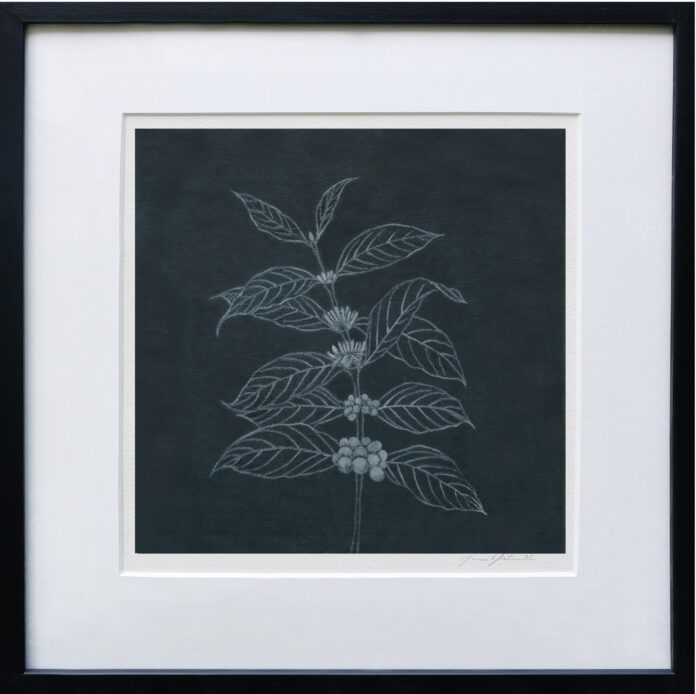
Together editor Catherine Feore meets Janise Yntema, an artist who has become an activist.
Janise Yntema is a leading authority on encaustic painting. The technique can be traced back to antiquity, with evidence of its use from as early as the fifth century BC. Wax, resin and pigment are mixed to become what Yntema describes as the first paint.
The word encaustic originates from Ancient Greek and means “burning in” as it is created in a molten state. You can see its use in Etruscan death masks and in the murals of Pompeii. It fell out of favour when it was supplanted by tempera and fresco, which were less demanding methods in terms of time, heat and labour. After a hiatus of several centuries, it was rediscovered. More contemporary fans of the method include Jasper Johns who used it in his emblematic flag paintings.
“What I like about it, is that the materials used are all natural,” says Yntema. “It’s damar resin, beeswax and then pigment. It’s amazing to study how beeswax is produced, it produces a finish that is almost alive, an organic skin that changes its colour throughout the day. It’s not like acrylic or oil, it has a different feel, a softer and more organic natural feeling to it.”
plants on the ‘red list’ are on the verge of extinction from climate change, farming practices, invasive species, and the use of chemicals
Yntema has been honing this ancient painting technique for over 25 years, blending different media to produce atmospheric landscapes that have an ethereal quality. I met her at the “Considering Plants and the Question of Extinction: Drawings from the Red List” exhibition of her work at the Meise botanical garden (www.plantentuinmeise.be). The beeswax on paper drawings of plants are a departure from her landscapes, but a continuation of her passion for the environment. The pictures are part of a series that she has been developing of plants that are now on the “red list” of critically endangered species; plants that are on the verge of extinction from climate change, farming practices, invasive species, and the use of chemicals.
“By studying and working with beeswax, it is a small step to researching plants. We’re all familiar with the distressing pictures of polar bears in the Arctic Circle, but what’s happening with plants does not receive the same attention and yet it’s the same situation. Plant extinction has always been occuring, but now it’s accelerating with changes to the environment and the use of chemicals.”
The paintings are inspired by the botanical classification systems of the 17th and 18th century, as well as 19th century daguerrotype portraits, the first commercial photographs invented at the end of the industrial revolution.
“Each plant has its own sentient spirit. For me, these works are like portraits”
“Each plant has its own sentient spirit. For me, these works are like portraits. These plants are so fragile, they have no way of communicating audibly with us – which is what we think is intelligence.” The exhibition is Yntema’s way of giving these plants a voice, capturing their beauty and imbuing them with a ghost-like quality. Anyone who has read Dickens’ ‘A Christmas Carol’ will know that ghosts appear to warn us. The drawings are a reminder of the existential choices we are facing in a world that is rapidly warming. “Normally botanical drawings are done in watercolour and a very beautiful light; I drew inspiration from daguerrotype portraits to give them a more somber quality.”
Working with beeswax has inevitably resulted in acute concern for our environment. In 2017 she presented a lecture entitled: “The Politics Behind the Bees” at the International Encaustic Conference, and in 2019, continued with the lecture: “The Environmental Politics of Wax and the Future of Encaustic.” For Yntema, beeswax reveals the complex mystery of the natural world, the inherent beauty of all life and the irreplaceable need for environmental conservation.
This sense of urgency was made more acute during the Covid crisis, the intertwined nature of our lives with the natural world was made more raw: “During the pandemic I stopped working. When I slowly started working again; it was important for me to do something with social relevance. I wrote to different botanical gardens and found out about red lists. The Botanical Garden in Edinburgh was very helpful.”
Exhibiting this summer in the National Botanical Garden of Ireland in Dublin and Meise Botanical Garden is a way for Yntema to acknowledge the singular work that these gardens do in documenting and preserving our botanical heritage. In the booklet that accompanies the exhibition there is a quote from Dr Alex Davey, Science Policy and Impact Officer, Royal Botanic Garden Edinburgh: “Plant species are becoming extinct at an extraordinary pace: some 500 times faster than the natural background rate […]. Over a third of flowering plants and almost 40 percent of conifers are now classed as threatened with extinction.”
The exhibition is open to 17 September. It can be found in the Square tower in the Castle of Bouchout, situated in the Meise Botanical Garden. It’s also a wonderful opportunity to visit the green houses that include almost 10,000 plant species from all tropical, subtropical, and warm temperate regions of the world, 10% of which are not found in any other botanical garden in the world.
The outdoor plant collections consist of more than 7,000 different species of plants: trees, shrubs, and herbaceous plants. There is an extensive collections of conifers, oaks, wild roses, and bamboo; beautiful horticultural collections of magnolias, rhododendrons, hydrangeas, peonies, and maples; and various thematic collections such as winter flowering plants, medicinal, culinary, and ornamental plants.
There’s also an excellent cafe!
www.janiseyntema.com
www.plantentuinmeise.be
Article first published in July.


















